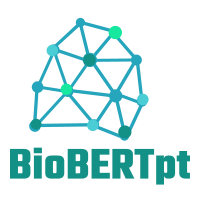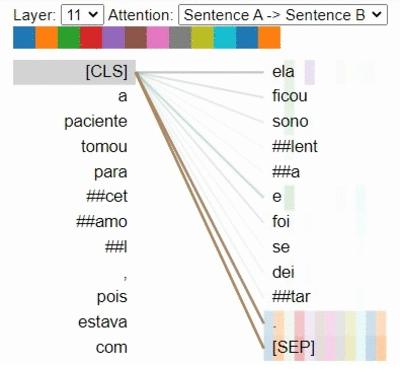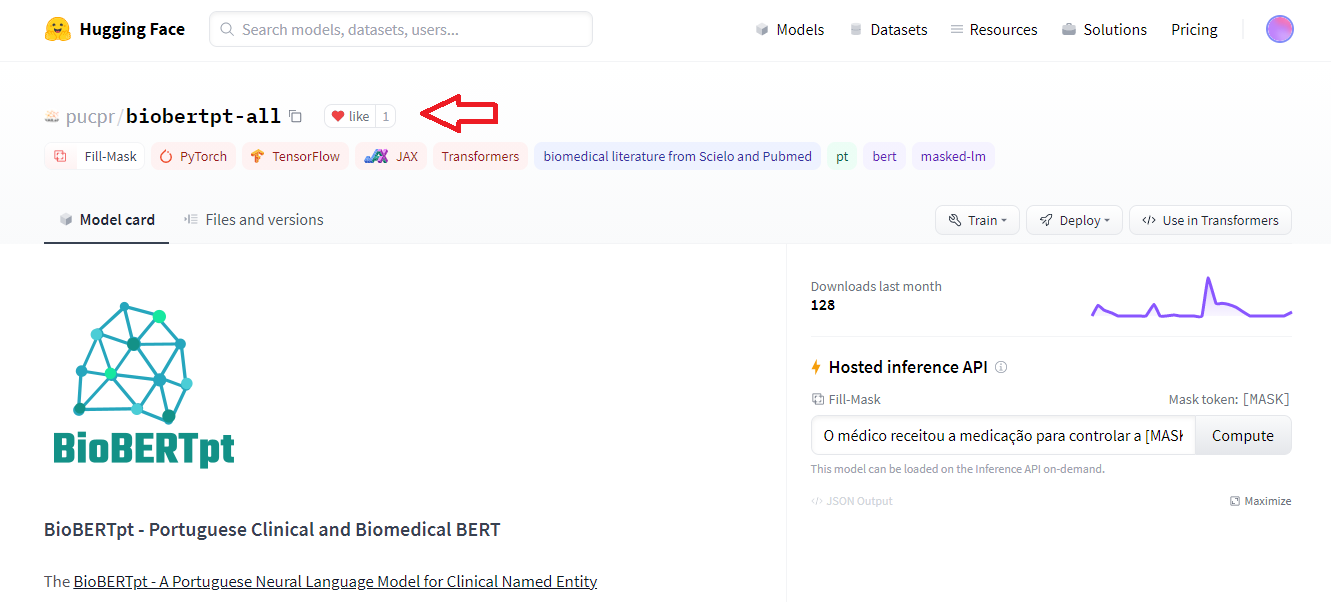** new: how to use the model for NER task, see below **
This repository contains fine-tuned BERT models trained on the clinical domain for Portuguese language. Pre-trained BERT-multilingual-cased were fine-tuned with clinical narratives from Brazilian hospitals and abstracts of scientific papers from Pubmed and Scielo.
Students:
- Elisa Terumi Rubel Schneider1
- Jenny Copara2
- João Vitor Andrioli de Souza1
- Julien Knafou2
- Lucas Emanuel Silva e Oliveira1
- Lucas Ferro Antunes de Oliveira1
- Yohan Bonescki Gumiel1
Professors:
- Cláudia Maria Cabral Moro Barra1
- Douglas Teodoro 2
- Emerson Cabrera Paraiso1
1 Pontifícia Universidade Católica do Paraná, Brazil
2 University of Applied Sciences and Arts of Western Switzerland
This is a example of the attention visualizing in the Transformer model with BioBERTpt(all), using BertViz. The attention-head view visualizes the attention patterns produced by one or more attention heads in a given transformer layer.
(...)
model_version = 'pucpr/biobertpt-all'
do_lower_case = True
model = BertModel.from_pretrained(model_version, output_attentions=True)
tokenizer = BertTokenizer.from_pretrained(model_version, do_lower_case=do_lower_case)
sentence_a = "A paciente tomou paracetamol, pois estava com febre."
sentence_b = "Ela ficou sonolenta e foi se deitar."
show_head_view(model, tokenizer, sentence_a, sentence_b)
BioBERTpt models are on Hugging Faces repo:
BioBERTpt(all): A clinical and biomedical language model for Portuguese
BioBERTpt(clin): A clinical language model for Portuguese (trained with EHR from hospitals)
BioBERTpt(bio): A biomedical language model for Portuguese (trained with scientific papers from Pubmed and Scielo)
These models were fine-tuned on Portuguese clinical and biomedical data, from BERT-multilingual. These models refers to in-domains models, without a specific task.
If the models were useful, we would love to receive a like ❤️
Next, see how to use BioBERTpt models for the NER task.
We evaluate our models on SemClinBr, a semantically annotated corpus for Portuguese clinical NER, containing 1,000 labeled clinical notes. These corpus comprehended 100 UMLS semantic types, summarized in 13 groups of entities: Disorders, Chemicals and Drugs, Medical Procedure, Diagnostic Procedure, Disease Or Syndrome, Findings, Health Care Activity, Laboratory or Test Result, Medical Device, Pharmacologic Substance, Quantitative Concept, Sign or Symptom and Therapeutic or Preventive Procedure.
All NER models are available in the Hugging Faces repository.
The table below shows complete F1-score results for each entity in SemClinBr, where the last three models (in italian) are our in-domain models. In bold, the higher values.
| Entity / Model | Disorders | ChemicalDrugs | Procedures | DiagProced | DiseaseSynd | Findings | Heatlh | Laboratory | Medical | Pharmacologic | Quantitative | Sign | Therapeutic |
|---|---|---|---|---|---|---|---|---|---|---|---|---|---|
| BERT multilingual uncased | 0.7868 | 0.9026 | 0.6696 | 0.5462 | 0.5624 | 0.5034 | 0.3735 | 0.3778 | 0.5585 | 0.7557 | 0.6068 | 0.5185 | 0.4874 |
| BERT multilingual cased | 0.7823 | 0.9010 | 0.6744 | 0.5193 | 0.5380 | 0.5046 | 0.4123 | 0.4168 | 0.5927 | 0.5927 | 0.6129 | 0.5366 | 0.4862 |
| Portuguese BERT large | 0.6250 | 0.7823 | 0.4525 | 0.5043 | 0.5745 | 0.5264 | 0.3355 | 0.4041 | 0.5135 | 0.7225 | 0.5615 | 0.5517 | 0.4888 |
| Portuguese BERT base | 0.7844 | 0.9038 | 0.6721 | 0.5558 | 0.5399 | 0.500 | 0.3462 | 0.4223 | 0.5366 | 0.7754 | 0.5676 | 0.5375 | 0.4712 |
| BioBERtpt (bio) | 0.7853 | 0.8939 | 0.6893 | 0.5507 | 0.5749 | 0.5260 | 0.4591 | 0.3981 | 0.6042 | 0.7237 | 0.5919 | 0.5335 | 0.5008 |
| BioBERtpt (clin) | 0.7805 | 0.9109 | 0.6855 | 0.5595 | 0.5829 | 0.5207 | 0.4057 | 0.4526 | 0.5618 | 0.7791 | 0.5926 | 0.5435 | 0.4593 |
| BioBERtpt (all) | 0.7913 | 0.9042 | 0.7032 | 0.5481 | 0.5641 | 0.5173 | 0.4037 | 0.4400 | 0.5552 | 0.7472 | 0.5997 | 0.5657 | 0.5128 |
Load the model via the transformers library:
from transformers import AutoTokenizer, AutoModel
tokenizer = AutoTokenizer.from_pretrained("pucpr/biobertpt-all")
model = AutoModel.from_pretrained("pucpr/biobertpt-all")
- Download a fine-tuned model for NER
- See how to use a NER model (notebook).
- How to use the model with docker
Please download the amazing Huggingface implementation of BERT.
For more information, you can refer to these examples.
To replicate our work, or fine-tune you own model, just do this steps:
git clone https://github.com/huggingface/transformers
cd transformers
pip install .
mkdir data
# please put your corpus file in this folder in a txt format
python examples/run_language_modeling.py --output_dir=output --model_type=bert \
--model_name_or_path=bert-base-multilingual-cased --do_train --train_data_file=data/corpus.txt --num_train_epochs 15 --mlm \
--learning_rate 1e-5 --per_gpu_train_batch_size 16 --seed 666 --block_size=512
This study was financed in part by the Coordenação de Aperfeiçoamento de Pessoal de Nível Superior - Brasil (CAPES) - Finance Code 001.
@inproceedings{schneider-etal-2020-biobertpt,
title = "{B}io{BERT}pt - A {P}ortuguese Neural Language Model for Clinical Named Entity Recognition",
author = "Schneider, Elisa Terumi Rubel and
de Souza, Jo{\~a}o Vitor Andrioli and
Knafou, Julien and
Oliveira, Lucas Emanuel Silva e and
Copara, Jenny and
Gumiel, Yohan Bonescki and
Oliveira, Lucas Ferro Antunes de and
Paraiso, Emerson Cabrera and
Teodoro, Douglas and
Barra, Cl{\'a}udia Maria Cabral Moro",
booktitle = "Proceedings of the 3rd Clinical Natural Language Processing Workshop",
month = nov,
year = "2020",
address = "Online",
publisher = "Association for Computational Linguistics",
url = "https://www.aclweb.org/anthology/2020.clinicalnlp-1.7",
pages = "65--72",
abstract = "With the growing number of electronic health record data, clinical NLP tasks have become increasingly relevant to unlock valuable information from unstructured clinical text. Although the performance of downstream NLP tasks, such as named-entity recognition (NER), in English corpus has recently improved by contextualised language models, less research is available for clinical texts in low resource languages. Our goal is to assess a deep contextual embedding model for Portuguese, so called BioBERTpt, to support clinical and biomedical NER. We transfer learned information encoded in a multilingual-BERT model to a corpora of clinical narratives and biomedical-scientific papers in Brazilian Portuguese. To evaluate the performance of BioBERTpt, we ran NER experiments on two annotated corpora containing clinical narratives and compared the results with existing BERT models. Our in-domain model outperformed the baseline model in F1-score by 2.72{\%}, achieving higher performance in 11 out of 13 assessed entities. We demonstrate that enriching contextual embedding models with domain literature can play an important role in improving performance for specific NLP tasks. The transfer learning process enhanced the Portuguese biomedical NER model by reducing the necessity of labeled data and the demand for retraining a whole new model.",
}


